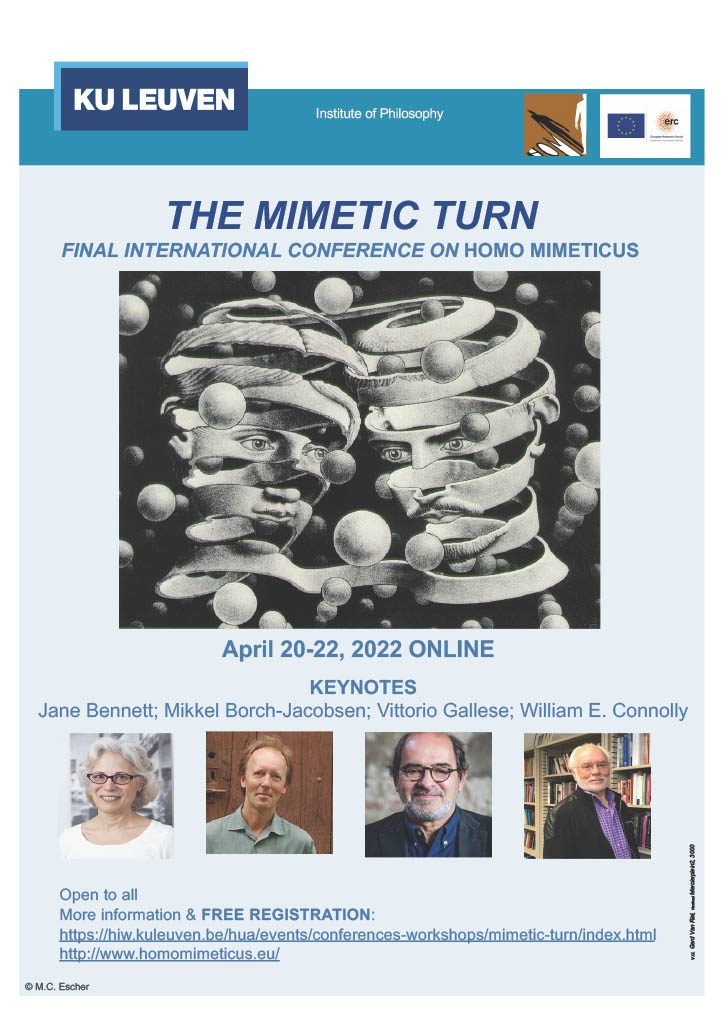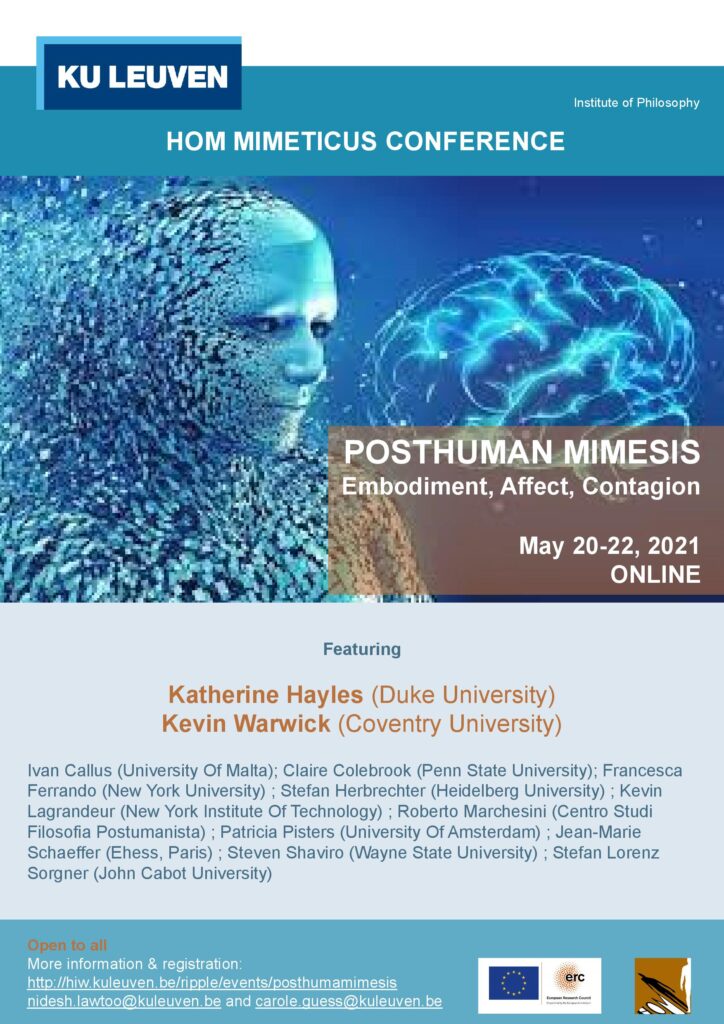In this last episode of HOM Videos, Nidesh Lawtoo returns to the place where mimetic studies begun: the Great Theatre of Dionysus in Athens. It is in fact here that mimesis was not simply represented but, rather, performed by actors on mimes endowed with the capacity to generate a mimetic, dramatic, or Dionysian pathos in the audience as well.
Tag Archives: contagion
Rebirth of Homo Mimeticus
In this discussion on the topic of “The Art of Imitation and the Desire for Violence: The Rebirth of Homo Mimeticus,” we have tried to grasp the emerging concepts around mimesis, new age violence, and the return of the homo mimeticus.
Homo Mimeticus Book Launch and Conclusion
In this book launch of Homo Mimeticus: A New Theory of Imitation (Leuven UP, 2023, OPEN ACCESS), HOM/GM PI Nidesh Lawtoo joins forces with his team (Niki Hadikoesoemo, Marina Garcia-Granero & Giulia Rignano) to sum up the main results of the HOM project and open up the new transdisciplinary field of mimetic studies Homo Mimeticus proposes.
The Insurrection Moment: Insurrection, Conspiracy, Assault

In this HOM piece for a Theory & Event special issue on the Storming of the Capitol on January 6, Nidesh Lawtoo furthers mimetic studies by discussing the role of Dionysian intoxications, conspiracy theories, and dispossession in the company of Nietzsche, Deleuze and Black Mirror. Article available OA here
Viral Mimesis: The Patho(-)Logies of the Coronavirus (N. Lawtoo)

In this article, Nidesh Lawtoo argues that the human, all too human vulnerability to mimesis (imitation) is a central and so far underdiagnosed element internal to the Covid-19 pandemic crisis. Supplementing medical accounts of viral contagion, the chapter develops a genealogy of the concept of mimesis – from antiquity to modernity to the present – that is attentive to both its pathological and therapeutic or patho-logical properties. Read full article here.
The Mimetic Turn: HOM Final Conference, April 20-22.

The ERC-funded project Homo Mimeticus: Theory and Criticism (HOM) hosted by the Institute of Philosophy and the Faculty of Arts at KU Leuven, Belgium, is pleased to announce its final international conference titled The Mimetic Turn (April 20-22, 2022; ONLINE). Keynotes and Invited Speakers include Mikkel Borch-Jacobsen, Vittorio Gallese, Jane Bennett, William Connolly, Henry Staten, among other internationally renowned theorists and critics. Recordings here
HOM Theory: Mimetic Patho(-)logies in the Age of Covid-19 (N. Lawtoo / LMU)
In this public lecture for the LMU Doctoral Program on Mimesis Final Conference, Nidesh Lawtoo (KU Leuven) articulates the relevance of HOM Theory to account for the mimetic patho(-)logies in the Age of Covid-19: from affective contagion to viral contagion, conspiracy theories to therapeutic imitations, Lawtoo argues that rethinking mimesis beyond representation is central to account for the patho(-)logies of contagion in periods of pandemic crisis.
Posthuman Mimesis: Embodiment, Affect, Contagion (May 20-22)

The ERC Project Homo Mimeticus: Theory and Criticism is pleased to announce an international online conference on the subject of “Posthuman Mimesis.” More details including program and registration here.
Allegories of Contagion: Jean-Luc Nancy on (New)Fascism, Democracy, and COVID-19
In a forthcoming interview for HOM to be published in a special issue of CounterText dedicated to examining what we call a mimetic re-turn in the post-literary sphere, Jean-Luc Nancy and Nidesh Lawtoo take a deep look at various mimetic phenomena that characterize the current condition of homo mimeticus, among them the recent surge of (new)fascist tendencies in contemporary democracies and the COVID-19 crisis. Both (new)fascism and viral contagion are paradigmatic mimetic phenomena—but how are they related?
Let’s begin with what Lawtoo calls (new)fascism. For Nancy, the recent surge in this phenomenon owes to a crisis resulting from a condition that belongs to the very definition of democracy. In a democracy, Nancy argues, there is nothing that stands in for its representative, the demos, until the performative moment—paradigmatically in the French Revolution—in which the people names itself as such: “we, the French people declare…” In this sense, Nancy says, democracy is perhaps a kind of “mimesis without a model” as theorized by his collaborator, Philippe Lacoue-Labarthe. Fascism’s recurring trick, both in the early twentieth century and today, consists in taking advantage of technological and economic crises to declare itself as “the truth of the people,” thus giving the people a figure, a series of representations that seek to fill a spectral absence at the heart of democracy by presenting themselves as the people itself. While the symbols employed by early twentieth century forms of fascism consisted of imagery and symbolism drawn from ancient Rome, contemporary figures combine more multifarious sources in the absence of the unifying force that classical culture held under Hitler and Mussolini.
Moreover, Nancy continues, political philosophy since Rousseau conceives the community as an organism in which all its parts are integrated into a unity whose end is itself and which subordinates some parts of the body to others according to their function. “If I am the little finger,” Nancy quips, “I cannot do as many things as, for example, the eye can.” Early fascisms have taught us that carrying this organic metaphor to completion is not only impossible, but leads to unimaginable catastrophes. On the other hand, however, the relative disappearance of the nation today also poses problems for state democracies, whose unity consists of mere remainders in immense technological and economic networks that leave subjects feeling lost, abandoned, purposeless. For Nancy, this is an aporetic condition: either one projects oneself completely to the outside—“thus one is necessarily a philosopher or an artist”—but ends up detached from society, or one mourns the loss of the nation while building the kind of resentment that Nietzsche and Scheler described as the consequence of the unbearable loss of connection.
In this respect, Nancy says, the recent COVID-19 pandemic “offers us a magnifying mirror of our planetary contagion.” Indeed, as Nidesh Lawtoo has noted in a recent post for The Contemporary Condition, this crisis is a mimetic phenomenon in more than one way: not only because of the literally viral process of copying that enables it to reproduce itself through other living beings, but because of how it renders subjects vulnerable to affective contagion—from anxiety and panic to solidarity and sympathy.

Nancy’s “magnifying mirror,” also affords him an opportunity to envision the difficulties the crisis portends for our collective futures:
We have the same fears, the same expectations—the end of capitalism and the beginning of ecological cleansing or, on the contrary, threats to freedom—and everything is extremely expected, repetitive, and codified. At the same time, it is a contagion that is developing less perhaps because of the severity of the sanitary risks than because of the important differences between countries, governments, and opinions. All of a sudden, the world seems deprived of direction or support. All of a sudden, states become important again. All of this moves slowly towards a tomorrow which will be complicated and conflictive in various ways, since it will be mixed with ecologic problems that are still awaiting our attention—and all of this will take place in what, as it seems, will be a very problematic economy.
But the interesting question is whether something can produce a new contagion: something new that I will call spiritual, as this is where things must go. I would like to say through the spirit of a world. It was through the plagues and the wars of the fourteenth and fifteenth centuries that Europe invented humanism and capitalism, classical art, the thoughts of reason and experience as well as literature. Machiavelli described the plague in Florence at the same time as he developed a concept of the modern state. However, he and the others of his time did not have behind them a history that had run out of breath…

The mirror is an old metaphor for mimesis—as old as Plato’s denunciation of the ontologically-degraded status of what is reflected on its surface. A magnifying mirror, however, calls attention to the effect that the mirror itself has upon what is reflected—it exposes the trick that Plato intended to carry out by dubbing the products of mimesis an unsubstantial reflection. The magnifying mirror transforms that supplementary reflection into a tool for detailed analysis, an analysis that, unlike a magnifying glass, is not directed at an object but at the subject itself—it is not a tool for theoria or contemplatio but one forreflectio. As in the overarching trope of the mirror in Renaissance vanitas paintings (contemporaries of the turning points, the krises, that Nancy evokes), the mirror also reveals veritas: the motivations, inclinations of the onlooker and, in case of memento mori paintings, of their mortal—and mimetic—condition.

Allegories, as Walter Benjamin once noted, reveal truth as a historical process of decay. To follow Nancy in approaching the virus as a magnifying mirror is to remember that the true causes of the crisis lie elsewhere: in the unequal conditions caused by global capitalism, in the supplementary role of (new)fascist leaders that presume to give a figure to a people that does not appear as such, in the technological co-optation of attention and information through digital media that allow for (new)fascist leaders to shape global narratives; as this happens, biological contagion continues its spread—disproportionately affecting the most vulnerable racialized populations in North and South America—leaving in its wake a death-toll whose official numbers are but a phantom of the true extent of the crisis.
Daniel Villegas Vélez
COVID-19: Viral Contagion / Mimetic Contagion
What is the link between mimetic contagion and viral contagion? Building on a diagnostic insight that called attention to the danger of “contemporary pandemics that, every year, threaten to contaminate an increasingly globalized, permeable, and precarious world,” and, already in 2016, warned that “the shadow of epidemics looms large on the horizon” (chapter on “The Cooperative Community: Surviving Epidemics in The Shadow-Line“), the HOM project continues the diagnostic in the context of COVID-19 in a series of interviews and posts.
Given the rapid global spread of coronavirus, it is increasingly essential to distinguish between viral contagion based on medical facts, and emotional reactions based on mimetic reflexes. In this radio interview, Nidesh Lawtoo cautions against mimetic affects, like panic, but also distinguishes between ideologically-driven forms of mimetic contagion and empirical viral contagion. If (new) fascist politicians spread lies about COVID-19, the latter should not be downplayed for economic reasons. It should rather lead citizens to listen to scientists and become aware of (and restrain) unconscious mimetic reflexes and habits (e.g., large assemblages, shaking hands etc.). Full radio interview (in Italian) with RSI, Rete 1 here ; written interview for LaRegione here.
Wojciech Kaftanski follows up on the diagnostic with a piece on mimetic contagion and COVID-19 for ABC that shows “how deeply we influence one another: from fights over toilet paper to declarations of war.” Article available here. Nidesh continues with a genealogy of mimesis–via Plato, Nietzsche and The Matrix–to face viral contagion in the Anthropocene in a piece for Fatamorgana. And in an interview for MSU Press’s Podcast, Nidesh discusses his new book (New) Fascism: Contagion, Comunity, Myth (MSU P 2019) in the context of the current pandemic crisis. You can listen to the podcast here.
Daniel Villegas Velez takes a forthcoming HOM interview with Jean-Luc Nancy as a starting point to reflect on the “Allegories of Contagion” that take COVID-19 as a “magnifying mirror” to reflect on (new) fascism. And in Lawtoo’s “The Mimetic Virus“ all these threads are woven together to “rethinking mimesis in the age of COVID-19” in The Contemporary Condition.

